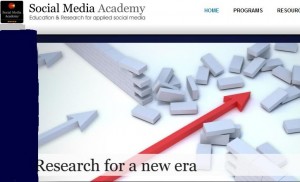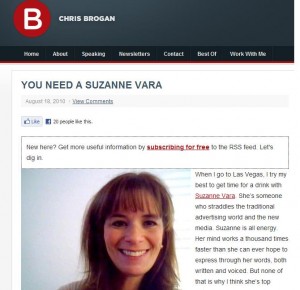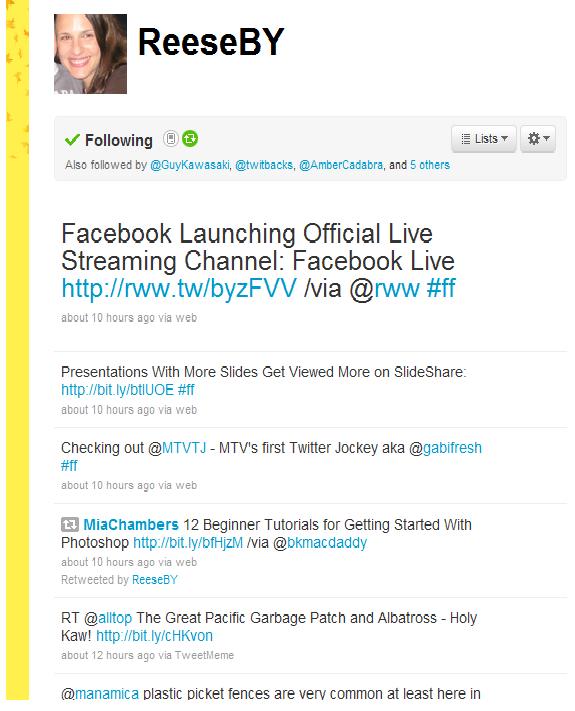 One of my most significant social media mentors has been Axel Schultze, CEO of Xeesm Corp and Social Media Academy, who was one of the first New Media notables to speak to my SFSU marketing students early in 2009.
One of my most significant social media mentors has been Axel Schultze, CEO of Xeesm Corp and Social Media Academy, who was one of the first New Media notables to speak to my SFSU marketing students early in 2009.
Axel has experience in a wide number of industries which you can check out on his LinkedIn profile that begins with this quote:
“You can’t make a difference while protecting your status quo.”
I had the great fortune to attend social media leadership training with entrepreneurs around the globe at Social Media Academy. We learned how NOT to protect the status quo and HOW TO take best advantage of the developing technology and changing world of commerce.
Here is a primer on the way to succeed in this Brave New world:
The Social Media Strategy Framework
a Guest Post by Axel Schultze
 In times where 60-80% of purchase decisions are based on recommendations, the best leverage of social media is making sure you are part of the recommendation chain. And that requires a sound business strategy.
In times where 60-80% of purchase decisions are based on recommendations, the best leverage of social media is making sure you are part of the recommendation chain. And that requires a sound business strategy.
There have been quite some discussions about social media strategies recently. So I thought I’d share what we have developed over the course of the past three years — and is today in practice by some 40+ social media managers and consultants in many parts of the world and vetted by some 20+ mostly corporate social media strategy projects.
Admittedly this framework may not apply to a small business below 20 people. But even there it may be helpful to see the components.
The Strategy Hexagon (six components) is based on two assumptions:
#1 A thorough social media assessment was conducted and uncovered where customers are, their major issues and topics, the actual current presence of the brand in the social web, the company’s partners’ presence, and the completion landscape. We developed a specific four-quadrant assessment model to do that.
#2 The strategy is really a strategy and not, like so often, an execution plan. We developed a social media planning framework to actually plan the execution of the strategy.
The Strategy Hexagon is built on six major components, which some are very traditional business strategy models and some are rather unique. The content of those six components however is entirely focused on social media — beginning with the composition of the strategy team. It is part of the Social Media Masters Class, where attendees actually create a strategy to get hands-on experience.
Strategy Team Composition
Let me start with this as it is the first OMG (yes, Oh my god). Unlike a traditional business strategy which is developed in some marble towers board room under exclusion of anybody not part of the executive team, a social media strategy requires you include customer and partner representatives from the get go. You will fail if you ignore this first major requirement for a successful strategy
The six core components
Goals
What is the strategy’s goal, i.e., what is completion?
As a sound and well run social media strategy is executed WITH the market and not a promotion AT the market, make sure that the goal includes objectives that resonate with your customers, partners and other strategic market constituencies. Increasing brand value may be YOUR goal, but who else cares?
Example:
Creating a better customer experience measured by reaching 1,000 positive public feedbacks from customers by end of the year.
The above example is in the interest of the customer as well as the interest of the company. It is measurable (sentiment analysis) and has a definitive timeline.
Mission
What are you going to do to achieve this goals?
Now you will want to describe in easy-to-understand sentences what you want and need to do to achieve the above goal. Already here it is of outmost important that you have market representatives with you in the strategy development as they will be part of the execution. It is equally important that you’ve done your homework on the audit/assessment, so you know what the wants and need of your market is.
Example:
The mission is to engage in the social web across departments and company boundaries. We want to learn from the market to build better products and return better services to the market. We want to ease administration to reduce cost and make it easier to work with us as an organization. We want to augment our support efforts with highly experienced customers to provide better support at a lower average cost.
As you can read in this example the mission again is beneficial for both, the company and the customer.
Benefits
How will your ecosystem and the company benefit from that strategy?
What are the actual improvements?
In order to be very clear in the strategy execution we will now want to mark the main benefits for both, company and customer and also show very clearly the improvements.
Example:
Customers will get more influence in the product design work and new product development to better serve their needs.
The company will get faster and more direct market feedback and reduce the risk of product failure and market research cost.
Unlike in the past where the company explored customer needs through surveys to design next generation products, we will actively work with interested customers on product co-creation and leverage the collaborative effort to get support from those customers to launch the new product.
Customers will get better support by having a support community where not only product specialists answer questions but also engaged customers. Unlike in the past where there was only customer driven forums, the company will build a support community and honor the support of active customers to get a wider support for all customers in one place.
We always used “Unlike…. Now we…” to very clearly describe the difference and improvements as this helps people who are not part of the strategy development to know what they need to do to actually create the difference.
Resources
Participants, influencer & Leadership
This is basically a list of key resources by name and social web presence. This is NOT a list of companies or departments but people. Other resources may be locations to do certain things (physical or virtual). We also want to recognize leadership to make it very clear that customer representatives are part of the leadership of this strategy in certain capacities both in contribution and oversight of the project.
Actions / Methods
What are the actionable items of your strategy?
What are you really going to do to make it happen?
What will change (before – after analysis)?
Now once it comes to “Actions” we don’t want to develop the actual programs. This is what we want to leave to the respective departments, customers and partners. But we want to define what programs we need to execute the strategy. Those programs must all lead to the goal and be in alignment with our mission. Everything else would need to go in the “nice to have box”.
Examples:
Support Community Program
In this program we will need to build an online support community, motivate customer to help customers, recognize the most supportive customers with a rewards and reputation program and help the professional service organization understand that this is not cutting into the paid support business. The program will be supported by … from … (customers) to ensure that it works for most customers.
Product Co-Creation Program
In this program we will want to have a direct feedback mechanism from selected customers to product management, build a product design community, with customer and market influencer help testing the first prototypes.
Product Launch Program
In this program we want to develop a general framework that we can use to launch a product. We will want to include customer advocates, the co-creation participants and market influencer to help introduce new products the social media way.
Customer Administration Program
In this program we will want an ongoing process where customers help through feedback uncover administration insufficiencies. The program shall help to make it easier to do business with us (specific complains will be uncovered in the assessment).
Customer Advocacy Program
In this program we will need to both monitor and encourage customers to advocate for the company’s products / services etc.
Reporting
How do we measure progress and success
Last but not least we define the key performance indicator and as result select tools and methods to report on progress and results. And while we are all in this for business reasons, revenue is NOT part of the reporting. Not that we don’t care – NOT AT ALL – but revenue is an after the fact control measure.
If it is not coming, it is too late. One of the unparalleled advantages of social media is our ability to track and measure instant impact – long before revenue stream is affected. A recommendation of one customer to another is long before the other customer may purchase. If that recommendation isn’t happening or we ignore it, all we have is a negative result in the future.
Examples:
- We want to track how many customers (users of products from the firms we sell to) are actually talking about our products.
- We want to know how much more doing this over time.
- We want to know what the sentiment of the discussion is and how this improves over time.
- We want to know how many suggestions are made and how this improves over time.
The majority of the KPIs are again driven by the result of the audit, which indicates best what customers want and need.
Don’t select tools and see what kind of interesting charts they can create. You will get tons of charts and reports that are all interesting. Instead be clear on what you need to know to maneuver the execution of your strategy and reach your goal.
In our particular example we want to see 1,000 positive feedbacks from customers, written publicly.
Summary
I guess you get a good idea that a social media strategy is not a marketing gig to fire up a fan page and hope that people will like it. In times where 60-80% of purchase decisions are based on recommendations, the best leverage of social media is making sure you are part of the recommendation chain. And that requires a sound business strategy.



























